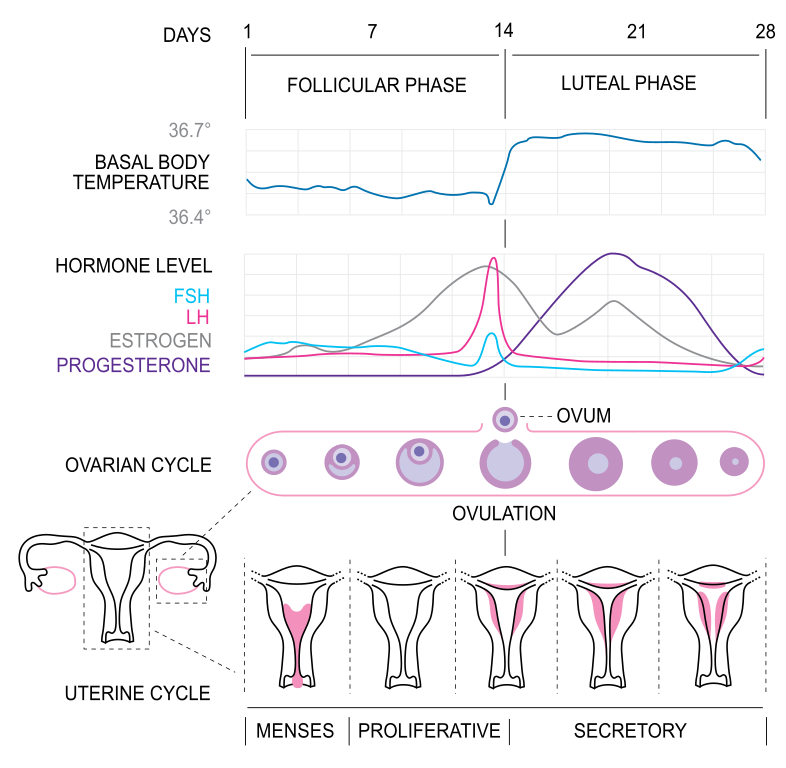Female Endocrinology
Menstrual Cycle Pattern
Normal Menstrual Pattern
The onset of the menstrual cycle occurs at puberty with the establishment of the hypohalamo-pituitary axis. The first bleeding is known as menarche which happens two years after breast bud development. 2–3 years after menarche—and around menopause—the hypothalamic-pituitary axis is immature, and these years are usually associated with irregular an-ovulatory cycles.
The normal ovulatory cycle pattern occurs every 24–32 days during reproductive years. The bleeding phase lasts approximately 3–7 days, with an average 30cc of blood lost. Nearly 80% of blood loss occurs in the first two days.
Signs of an Ovulatory Cycle
- A sustained high estrogen level: 200 pg/ml or more for about 50 hours before ovulation that precedes the peak of LH hormone.
- A surge/peak of LH hormone: > 20 mIU/ml that lasts 2–3 days at the midcycle (day 14 in the 28-day cycle). Ovulation and rupture of mature follicle occurs 24–48 hours after LH peak.
- High progesterone level at the midpoint of the luteal phase: 6.525ng/ml is produced by the developed corpus luteum.
- An increase of at least 0.4*F in the luteal phase over the proliferative-phase temperature is considered normal. As the circulating progesterone elevates, it rises the basal body temperature during the luteal phase.
- A change in cervical secretion into watery discharge at the midcycle with ovulation.
- A light pinkish-reddish spotting at the time of ovulation due to the slight drop in estrogen levels.

Different Patterns of Menstrual Bleeding with Ovulatory Cycles
- Infrequent bleeding that occurs at intervals greater than 35 days with prolonged cycles; A condition known as Oligomenorrhea, probably associated with prolonged corpus luteum activity.
- Frequent but regular episodes of uterine bleeding, usually at intervals of 21 days or less; A condition known as Polymenorrhea, probably due to a shortened follicular phase.
- Uterine bleeding that is excessive in amount and duration of flow is known as Menorrhagia (hypermenorrhea); bleeding occurs at regular intervals during ovulatory cycles.
- Inter-menstrual bleeding: uterine bleeding occurring between regular menstrual periods- mid-cycle spotting due to the drop in estrogen just before ovulation.
- A physiological absence of menses is known as Amenorrhea. This condition typically occurs during reproductive years in special situations (e.g., before or directly after menarche, pregnancy, lactation, or menopause).
Clinical Correlation
The chance of conception and occurrence of pregnancy is higher in polymenorrhea ovulatory cycles compared to oligomenorrhea ovulatory cycles due to multiple ovulations within a significant period.
Take Home Message
- The establishment of the menstrual cycle depends on the maturation of the hypohalamo-pituitary axis and the pulsatile secretion of GnRH.
- Different patterns of menstrual cycles may occur during the ovulatory cycle.
Image Sources
- Figure 1. “Menstrual cycle” is from Isometrik via Wikimedia Commons, licensed CC BY 3.0.

